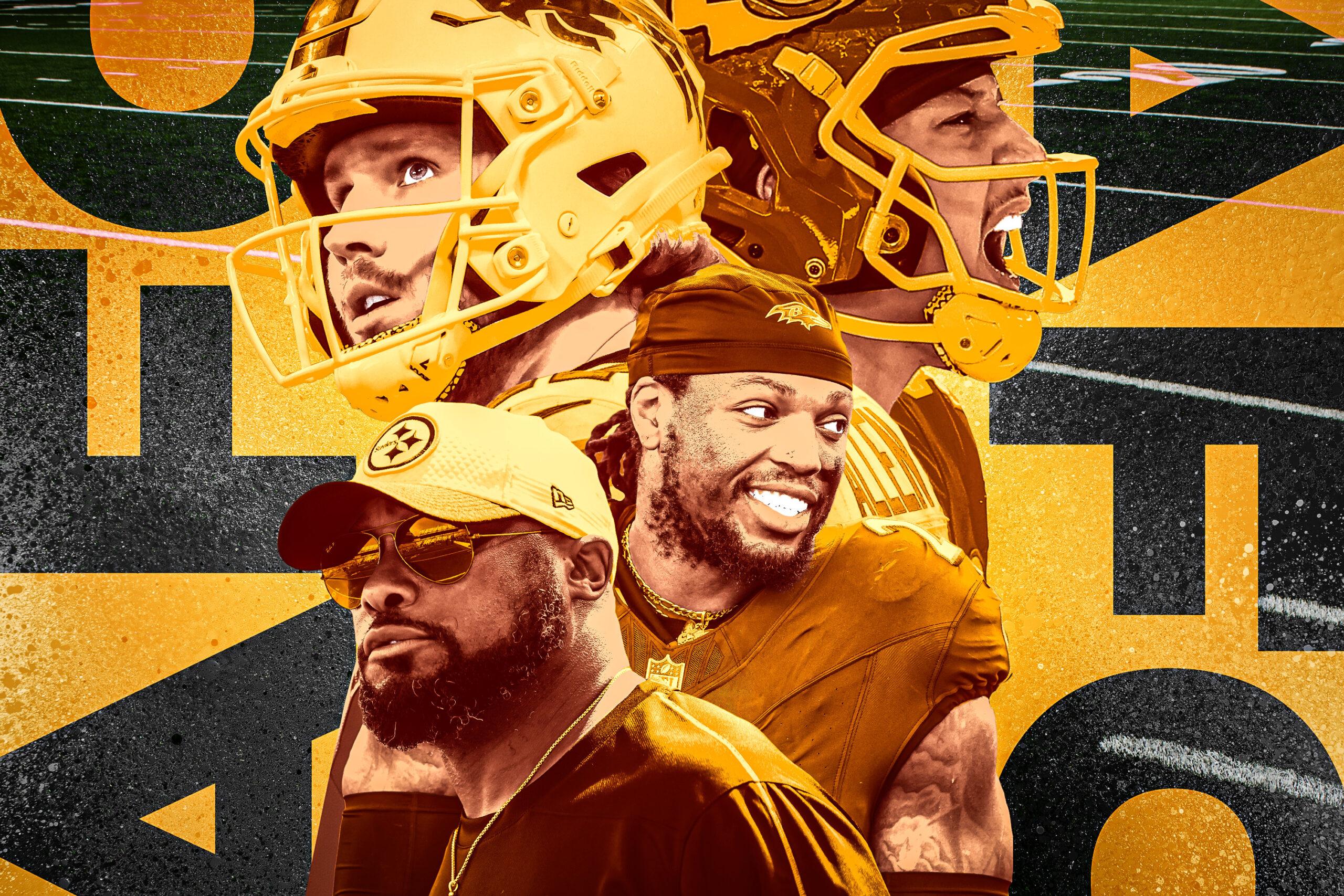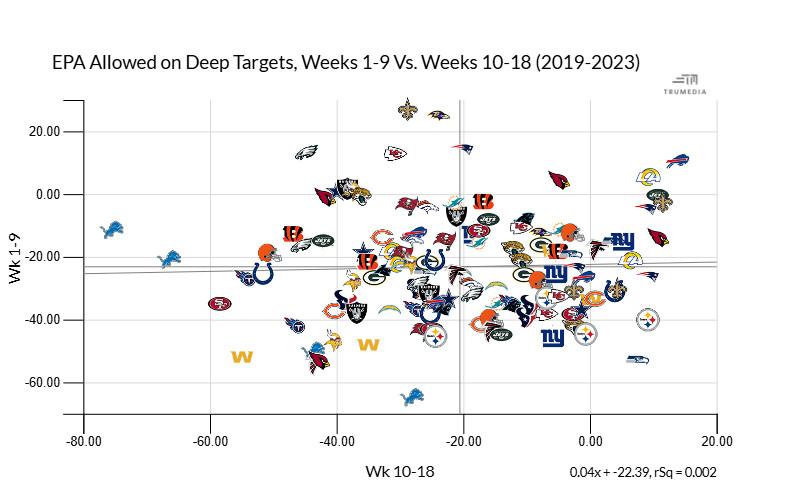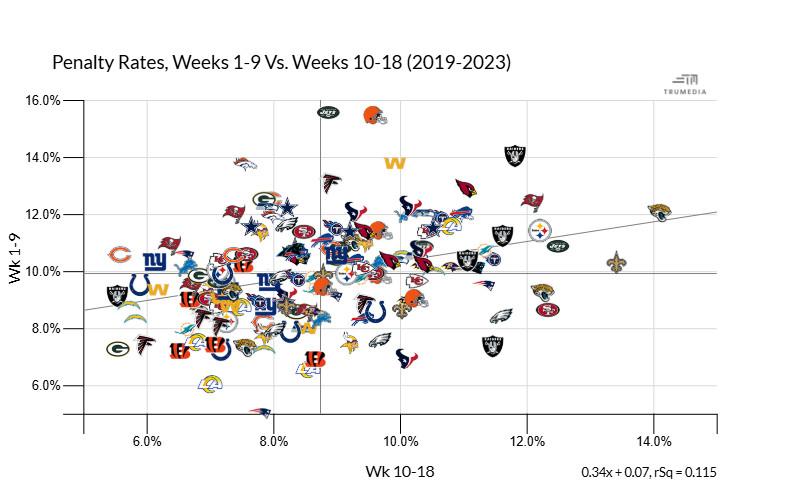
The power structure in the AFC made a lot more sense this time last week. The Chiefs were the clear favorites and had a head-to-head win over the Ravens. Baltimore appeared to be the defending champs’ closest competition, and it owned a convincing win over the Bills. By the transitive property, everything seemed pretty clearly sorted. And then Week 11 threw it all into chaos.
The Bills beat the Chiefs; the Ravens were upset by the Steelers, putting Pittsburgh in first place in AFC North; the Chargers impressed with a dramatic win over the Bengals; Denver continued its good form with a win over the Falcons; and the Texans had a get-right game with a big victory over Dallas.
It’s now harder than ever to answer this question: Who is the best team in the AFC? But let’s try to sort out this mess by looking at the most pressing concerns for each team and ranking them accordingly, starting with the team I’m most confident will represent the conference in the Super Bowl.
1. Baltimore Ravens
I can’t quit this team. It’s too talented, and its flaws—the offensive line is getting penalized to hell, and the secondary can’t defend a deep ball—can be easily fixed. Which makes it all the more frustrating that we’re this far into the season and they haven’t been fixed. Even with those flaws, though, and the fact that they’ve cost Baltimore four games, the team’s statistical profile suggests that it’s the best in the conference. The Ravens are second in the NFL in DVOA, behind Detroit. They’re first in offensive DVOA and EPA. They have the league’s best run defense, and rank third in sacks. If Baltimore can sort out the penalty and coverage issues before January, it should be considered the favorite to hoist the Lombardi Trophy in February.
And I think it’s highly likely the Ravens will improve in those two areas. These things tend to sort themselves out over a larger sample size. For instance, defensive performance against deep passes is highly susceptible to statistical volatility and can fluctuate wildly. Baltimore currently ranks 31st in EPA allowed on deep targets (over 15 air yards), but over the past five seasons, there’s been little correlation between how a defense performed against the deep ball in the first half of the season and how it performed over the second half.

Sure, there have been some instances where a team’s poor deep-ball coverage early in the season carried over into later in the year. But there are just as many examples of teams seeing a complete turnaround. Look at the big cluster of teams in the bottom right corner of the chart. That doesn’t mean the Ravens’ deep pass coverage is guaranteed to improve, but the data suggest that outcome is just as likely as their performance remaining the same. On tape, this scheme looks sound, and it isn’t all that different from the one Mike Macdonald ran last season. Baltimore’s secondary is loaded—they just need to eliminate the mental errors that have led to busted coverages under first-year defensive coordinator Zach Orr.
Penalties have also been a problem for the secondary. The team’s three starting cornerbacks have all been flagged at least four times this season. But the offensive line has been an even bigger offender. Patrick Mekari has been flagged 12 times, Ronnie Stanley nine times, and the other three starters a combined 12 times. They’re just lucky that Lamar Jackson has been good enough to overcome what would be drive-killing mistakes for other teams. Coach John Harbaugh said that Baltimore is “probably the best get-back-on-track offense in the league,” and he’s correct. But no offense can live like this long-term, and we saw why in Sunday’s loss to Pittsburgh. The offense committed six penalties, and Jackson was unable to put on the Superman cape to bail out his teammates. Most Sundays, he’ll be able to pull it off. But it will take only one when he doesn’t in January to end the Ravens’ season.
Harbaugh has taken the blame for the flags. “It stops with me,” he said Monday. “So it’s my job to make sure we’re doing the things that we have to do—from a coaching standpoint, from a drill standpoint, from an emphasis standpoint, technique standpoint—and making sure guys understand that it’s not OK.”
Harbaugh may not have to commit too much practice time to fixing the problem. As was the case with deep pass coverage, team penalty tallies over the first half of a season tell us little about how many they’ll rack up in the second half. The correlation is stronger than it is for deep coverage, but it’s still fairly weak.

If you can look past the penalties and coverage busts, there’s a lot to like about this team. With Derrick Henry in the fold as another explosive layer to the run game, the offense is more versatile than ever. Jackson is playing the best ball of his career and has performed well even in Baltimore’s losses. The run defense is also the best it’s been in years. This team ran Buffalo off the field, swept the Bengals, and nearly beat the Chiefs in Arrowhead. Its highs have been higher than those of any other team in the conference. Its lows have been pretty low, too, but the Ravens have everything they need to finally run the table in January … if they can just get out of their own way.
2. Buffalo Bills
The vibes in Buffalo are stellar compared to where they were a year ago. The Bills are heading into their bye week riding the high of a satisfying win over the Chiefs. And if the Dolphins lose their next two games (one this Sunday and one on Thanksgiving), Buffalo could clinch the AFC East before it steps on the field again in Week 13. At the same point in 2023, the Bills were sitting at 6-5; the playoff odds were not in their favor; they had just fired their offensive coordinator; Josh Allen was turning the ball over at an alarming rate; and injuries had decimated the defense. It was a rough start to the season, but Buffalo eventually got its act together, made the playoffs, and pushed Kansas City to the brink in the AFC divisional round.
The 2024 season has been more successful so far—and feels more promising. But the underlying metrics suggest this year’s team isn’t performing that much better than last year’s through 11 weeks. The Bills have won three more games, but their point differential has increased by only two points, from plus-104 to plus-106. The 2023 offense performed at the same level as this year’s unit by EPA and success rate. Even last year’s injury-plagued defense was ahead of this year’s pace in those two metrics.
Bills Defense Through 11 Weeks, 2023 Vs. 2024
That doesn’t mean the 2024 Bills are frauds or destined for a third consecutive divisional-round loss. It’s just proof that a few unlucky bounces and untimely interceptions can dramatically alter our perceptions of a team’s performance. Last year’s squad was good enough to win a Super Bowl, and the same is true for the 2024 version. But some of the concerns from 2023 have also carried over to this season. Pass coverage is at the top of that list. Buffalo’s defense has continued its pattern of padding its stats against bad offenses and getting picked apart whenever it comes across a top quarterback. They’ve found success facing off against Joe Flacco and Mason Rudolph, but their worst games have come against Jackson, C.J. Stroud, and Kyler Murray. Geno Smith and Patrick Mahomes didn’t light up the scoreboard against the Bills, but both finished with a positive EPA average. Even Aaron Rodgers had a good outing against this group in Week 6, and Tua Tagovailoa led Miami up and down the field in the Week 9 game.
The Bills have come out on top in most of those games thanks to Allen. For a second straight season, he’s playing like an MVP. And while Buffalo’s offensive production looks similar to 2023, this year’s team has more cards it can play. Joe Brady, who replaced Ken Dorsey as offensive coordinator last season, has built a robust run game, which can toggle between under-center and shotgun formations. That has improved the viability of the play-action pass game, which has made the offense more explosive. The offensive line has improved on last year’s solid group, and Brady is leveraging that strength more than Dorsey did. Thanks to the additions of Amari Cooper and rookie Keon Coleman, the receiving corps doesn’t revolve around one star. Cooper serves as the perimeter option, Coleman gives Allen a 50/50 ball-winner he can trust, and Khalil Shakir does everything else in between. Even the running back group has expanded. Allen is playing at the same elite level he did a season ago, and every other offensive position group is playing better.
If the Bills finally win the Super Bowl, they will have their more dynamic offense to thank. If they fall short once again, it will likely be because the defense failed to stop a top-tier quarterback. That’s been the case for the past three playoff exits, and it doesn’t appear much has changed.
3. Kansas City Chiefs
Alright, now that they’ve lost a game, let’s have an honest discussion about the Chiefs. The two-time defending champs are 9-1 and still have the inside track to home-field advantage with a relatively soft schedule down the stretch. But it’s a shaky 9-1—nine teams have a better point differential. And if Kansas City’s close-game luck regresses toward the mean—it’s 7-0 in one-score games this season—there could be some surprise losses left on the schedule. It would be foolish to question the Chiefs’ contender status, but this is the profile of a team we’d typically write off as fraudulent.
Those fraudulent teams don’t have Patrick Mahomes, though, who is still playing elite football, no matter what the numbers say. With Isiah Pacheco out and the run game sputtering, Mahomes has almost single-handedly dragged this offense to competence. Pacheco could return this week, which would solve some of the team’s offensive issues, but not all of them—the receiving corps being the biggest. Outside of Xavier Worthy, this is a slow, plodding group that doesn’t threaten defenses down the field. And as Worthy’s gone through typical rookie struggles—you have to get two feet down in the NFL, Xavier—he hasn’t been a reliable option either. This team is counting on Justin Watson to be its vertical route runner. And while DeAndre Hopkins can still make a contested catch downfield, he’s not creating separation or commanding safety help, which has allowed defenses to clamp down on the underneath throws Mahomes has favored over the past two Super Bowl runs.
It would be easy to blame the front office for this mess, but it wouldn’t be fair. This isn’t the group of pass catchers general manager Brett Veach envisioned before the season started. Injuries to Rashee Rice and Marquise Brown took out two of the team’s fastest wideouts. You can criticize Veach for not being more proactive in the trade market and allowing the Bills to get Amari Cooper, forcing the Chiefs to settle for the Hopkins trade a week later, but at least one report suggests they were never in the market for the former Browns receiver due to his age and the team’s cap constraints. Still, the missed opportunity could make a huge difference come January. It already did in Buffalo’s 30-21 win over Kansas City on Sunday, with Cooper hauling in two deep passes from Allen. Kansas City sure could use some of that downfield explosiveness right now.
The offense isn’t the only cause for concern. As much as we’ve harped on the problems on that side of the ball, the defense is ranked lower in both EPA and success rate than the offense this season, according to TruMedia, and its performance has declined over the past month.
Is the Chiefs Defense in Decline?
Pass defense has been the issue, and those problems can be traced back to the ankle injury Jaylen Watson suffered in Week 7. His replacement, Nazeeh Johnson, has been picked on by offenses whenever the Chiefs play man coverage. The Bills, in particular, went to town on the third-year cornerback, burning him for nine receptions, 103 yards, and a touchdown, per Pro Football Focus—though Johnson disagrees with the PFF charting. Watson is done for the regular season, but there’s hope that he could return during the postseason after having surgery in late October. Steve Spagnuolo’s defense is known for playing suffocating man coverage. That’s harder to do if there’s a weak link in the secondary.
DVOA has a more favorable view of the Chiefs defense, which ranks seventh in the metric. But DVOA is adjusted for opponent strength, and some of Kansas City’s worst defensive performances have come against Allen, Jackson, and Joe Burrow while it’s played well against other quarterbacks. On the one hand, that ought to allay some concerns about the unit’s numbers overall; on the other, those are some of the same quarterbacks they’ll have to beat to get back to the Super Bowl.
Despite all these obvious red flags, I’m not counting the Chiefs out. The coaching staff has earned the benefit of the doubt over the past few years. Mahomes may not be playing like the NFL’s best quarterback, but form is temporary, and nobody would be surprised if he turned it on in January. Still, this current version of the team is not good enough to win it all. There’ll have to be some evolution on either side of the ball in order for that to happen.
4. Houston Texans
I’ll just spoil it now: The Texans are the cutoff point on this list for teams I can see winning the AFC. DeMeco Ryans has his defense up and running in year two. They’re third in defensive DVOA and have had two dominant displays against championship-level offenses in Detroit and Buffalo. Will Anderson Jr. is set to return after missing two weeks with an ankle injury, and he’s one half of the NFL’s most destructive edge rushing duo along with Danielle Hunter. The secondary is also stacked with foundational players. Derek Stingley Jr. is a top-five cover corner, Jalen Pitre is a tone-setting nickel back who can cover and hit, and rookie corner Kamari Lassiter looks damn good for a 21-year old. Houston has Super Bowl-level talent on defense and Ryans has them playing hard.
The offense has been the main problem this season. The Texans rank 24th in offensive DVOA, and they’ve had a hard time putting points on the board in their games against teams with winning records, averaging under 19 points a game against the Vikings, Bills, Packers, and Lions. (Houston went 1-3 in those games.) The run game had been dragging down the entire offense over the first month of the season. Then Nico Collins’s injury in Week 5 tanked the pass game as well.
C.J. Stroud’s Stats With Nico Collins On and Off the Field
C.J. Stroud’s performance took a massive hit without his WR1 on the field. And he seemed to buckle under the increased pressure to make plays for the offense. His average time-to-throw increased, which led to more sacks and interceptions. And without Collins on the field, his completion percentage fell from 70 percent to 58 percent. But that’s hardly a concern now after Collins returned for Houston’s 34-10 win over the Cowboys. Stroud looked better in that game, and the offense scored more than 30 points for the first time in over a month. The run game, paced by Joe Mixon’s 109 rushing yards and three touchdowns, also looked much better. But Collins’s return probably had little to do with that part. The Texans had been running the ball more efficiently throughout his absence, with Houston averaging minus-0.07 EPA per run with the star receiver off the field and minus-0.21 EPA with him on it, per TruMedia. The explanation for that gulf is simple: The Texans haven’t run the ball well from three-receiver sets, and injuries to Collins and Stefon Diggs naturally led offensive coordinator Bobby Slowik to do less of that. Now, running the ball well against Dallas doesn’t prove that Slowik has figured things out—every team has run wild on the Cowboys, who rank dead last against the run by EPA allowed, per TruMedia. But that facet of the offense was showing signs of life before Monday’s contest.
Stroud looked like an elite quarterback early in the season with Collins out there, and I’d expect him to return to form now that he’s got his WR1 back. If Slowik can just get the run game operating at a league-average clip, the Texans will be a tough out come January. That remains a big “if.”
5. Los Angeles Chargers
The Chargers have basically become a value-brand version of the Chiefs in Jim Harbaugh’s first season. The defense, which has hovered around the top of the NFL in various efficiency metrics throughout the season, has done most of the heavy lifting, while the highly flawed offense has been carried by the quarterback—only the Chiefs have a track record of success while the Chargers have done nothing to earn our trust.
First-year defensive coordinator Jesse Minter, who followed Harbaugh to the NFL from Michigan, looks like the next big coaching star on the defensive side. There hasn’t been a key scheme or strategy powering this unexpected turnaround for the defense, which finished 26th in defensive DVOA in 2023. Instead, they’re doing a little bit of everything. Los Angeles has defended the run, mixed up its coverages to keep opposing QBs guessing, and hasn’t allowed many explosive pass plays. It’s a formula that has worked for great defenses throughout the history of the sport. And it helps that the Chargers stars, from Derwin James to Khalil Mack, are playing like stars. But there is a lack of top-end talent on this defensive roster, which is my only cause for concern about the sustainability of the unit’s success.
Despite Justin Herbert’s presence, I’m more concerned with the offense. There just isn’t enough talent in the receiving corps to sustain an efficient passing attack. Even with Herbert playing the best football of his career, the Chargers rank 14th in EPA per dropback and 23rd in success rate. Herbert’s numbers look better of late, but the receivers aren’t creating consistent separation against man coverage, and dropped passes remain an issue for this inexperienced group. We’ve seen across the league this season that there’s only so much a quarterback can do to elevate an offense that lacks talent, and L.A.’s deficiencies there will be difficult to overcome in the playoffs.
6. Pittsburgh Steelers
Of the seven teams on this list, the Steelers rank lowest in DVOA. I like this team—the defense, to be specific—more than the numbers do, but I also have a healthy amount of skepticism about its ceiling due to the offense. Russell Wilson’s return from injury has expanded the passing game, which has been built around his trademark moonballs. Wilson’s deepball prowess makes the offense more explosive compared to the Justin Fields-led pass game, but it hasn’t made it more consistent. While Wilson’s EPA and yards per dropback averages are higher than his backup’s, Fields has the better success rate this season, per TruMedia. And the quarterbacks’ underlying passing metrics, like off-target throw rate, sack rate, and time to throw, are pretty much identical.
Russell Wilson Vs. Justin Fields, 2024
Wilson is throwing interceptions at a much higher rate, so we can’t even say the veteran is playing smarter football. He threw one of the worst interceptions of the season on Sunday in the Steelers’ upset win over Baltimore.
The outcome of 50/50 deepballs has made the difference, and that’s not typically a formula for sustained offensive success. The win over the Ravens shows this team can hang with anyone when they’re getting bounces—but it’s hard to believe they’ll be able to do that three weeks in a row against top competition.
7. Denver Broncos
For the Broncos, just being included on this list should be considered a win. Hang the banner, Denver. But even with a dominant defense and an improving offense, it’s difficult to take this team seriously. The Broncos haven’t beaten another team on this list and haven’t scored more than 16 points in four losses against the Steelers, Chargers, Ravens, and Chiefs. The 41-10 loss to Baltimore, in particular, shows just how far this team has to go before it can compete with the teams at the top of the division. A great defense can carry a team far in January, but even the best defenses can get dunked on by an elite quarterback, as Jackson proved in the Week 9 blowout.
Some offensive improvements have taken some pressure off the defense over the last month. Sean Payton has been coaching his ass off to make things easier on his quarterback—Bo Nix just threw for over 300 yards and four touchdowns against Atlanta with an average depth of target of 4.2 yards—but even with the progress the unit has made, it looks like a flimsy house of cards. Nix is playing with more confidence, which has helped spark the midseason turnaround, but most of his production is coming on first down when defenses have to worry about defending the run. In more obvious passing situations, Nix has struggled.
Bo Nix’s Splits by Down
That’s not terribly surprising. Rookie quarterbacks tend to have trouble in situations where defenses can get creative with pressures and coverage disguises. But this is also kind of how the offense worked last season. Compare Nix’s passing splits in 2024 to Wilson’s in 2023.
Russell Wilson’s Splits by Down, 2023
The first-down numbers are essentially identical, while Nix holds an advantage on second down and Wilson was better on third downs. Either way, the takeaway is the same: this isn’t an offense you can trust on passing downs—and those plays are the ones that typically decide playoff games.

